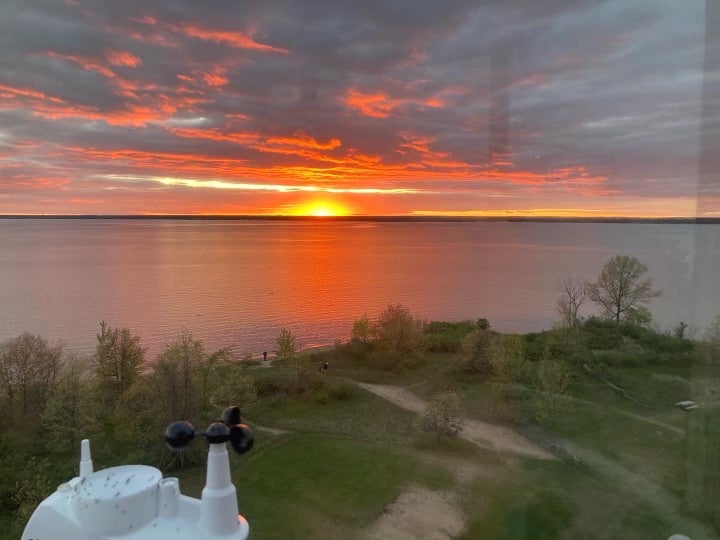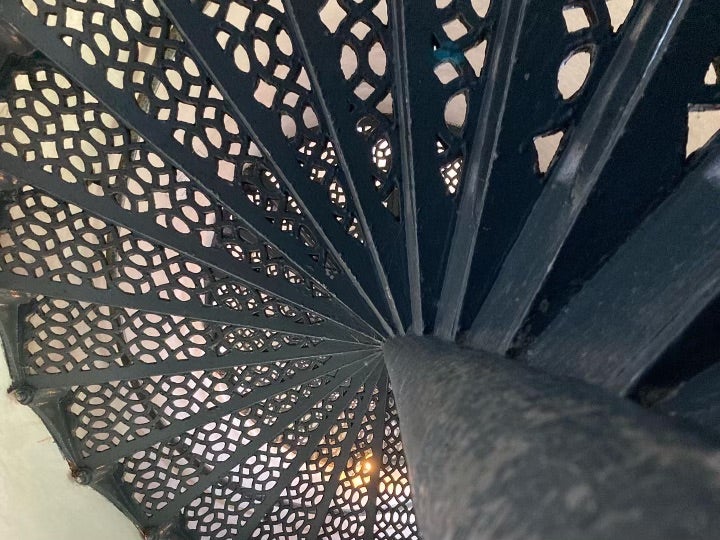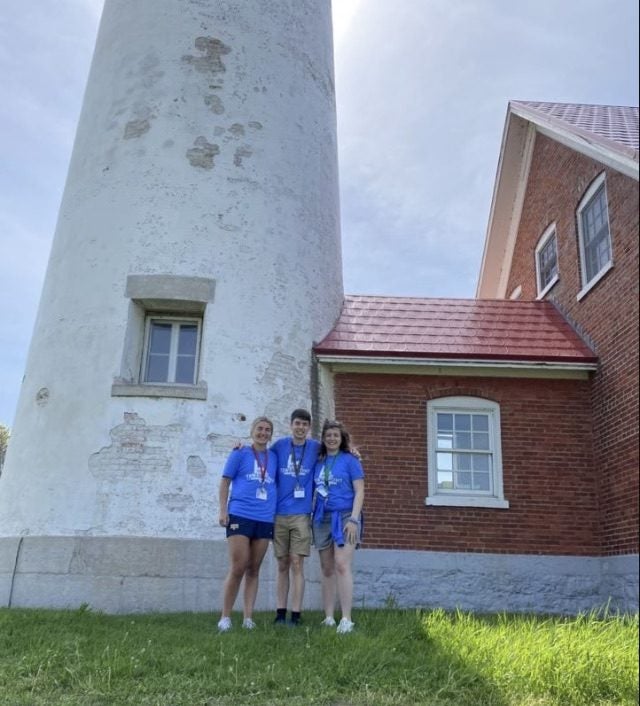For over a century, the beacon at Tawas Lighthouse guided ships on Lake Huron. During its operation, the light was manned–and, once, womanned–by lightkeepers who kept an often lonely vigil in weather that ranged from idyllic to deadly. Now a historical site maintained by Michigan’s Department of Natural Resources, the Tawas Lighthouse serves another purpose: providing a birdseye view of the U.S.’s third coast and a portal to the past for sightseers, history buffs, and lighthouse aficionados from Michigan and beyond.
In May, a team of undergraduates from the University of Michigan’s Great Lakes Writers Corps volunteered to serve a two-week term as Tawas Lighthouse Keepers. Living in the historic lighthouse, Noah Manuszak, Trinity Metcalf, and Lucy Baker raised and lowered the American flag, oversaw daily operations and basic maintenance of the lighthouse, and gave tours to visitors, leading groups up the 86 steps to the lantern’s platform for aerial views of the Tawas Point State Park, across Tawas and Saginaw Bays, and out over the 23,000 square-mile expanse of (by surface area) the planet’s third largest freshwater lake.

For the volunteer lighthouse keepers, these tours and the tourists they met provided still more perspectives, on Michigan, on history, and on, well, life.
“I didn’t experience this head on, because I was with two people and it was gorgeous–except one day it was 49 and rainy,” Noah recalls. “But as picturesque as it seems, lighthouse keeping can be a really lonely job.”
Trinity counters this by suggesting that they were not as alone on dark nights as she might have liked. “I swear there were ghosts there….one time I heard a woman talking outside. I expected her to come in but she didn’t. I went outside and no one was there.” Then again, she was then in the middle of reading Haunted Lighthouses.
Even early in the Michigan tourism season, the lighthouse keepers did have a lot of company.
“Some people just want to go up the lighthouse, some want to hear every little detail, some want to tell YOU every detail,” says Trinity. She remembers one couple who had already toured hundreds of lighthouses, from Australia to the UK, Maine to Vancouver.
“I’m supposed to be the expert, but they were so knowledgeable that I was asking them questions!”
When she started taking notes, the couple suggested books–Michigan’s 116 Lighthouses and Women of the Lighthouse–and recommended other great Michigan lights to visit, such as those on Whitefish Point and Isle Royale.
Lucy, meanwhile, started watching birdwatchers. In an article she is writing about her experience at the lighthouse, she describes the pre-Memorial Day flocks of birders at Tawas Point, a site designated an official Important Bird Area (IBA) by BirdLife International and the Audubon Society: “In athletic shorts and a UofM t-shirt (an outfit that would usually allow me to blend in), I felt like I stood out. The people around me wore camouflage, countless shades of tan, and binoculars around their necks. Some of them walked slowly, but most of them stood still, their necks craned and their eyes peering through scopes or cameras.” It was an eye- (or ear-) opening experience for her: “birdsongs have always served as background noise…This is just something you get used to as a Michigander. But as I passed the entry signs to the trail and began my walk, birdsongs became all I could hear. I became aware of the sound of my own footsteps on the soft, dirt trail. Heads turned as I accidentally stepped on small sticks, creating obviously unwanted noise.”
To prepare to be guides, the keepers were trained by the Michigan Department of Natural Resources historian and given a binder to study, and, once at the lighthouse, they explored the museum on site. Trinity studies earth sciences, Noah studies biology, and Lucy studies environmental science, so they were all intrigued by the story of how the Tawas Lighthouse came to sit a full mile from the shoreline. While many beaches experience erosion, Tawas Point has seen accretion occur, where the beach grows over time. As the land expanded, a previous lighthouse was replaced by the present structure, and when still more new land accumulated, a fog signal was added.
Visitors saw different things, according to their interests. Birders saw birds. Vacationers who confided that they’d ditched their husbands for a weekend of freedom enjoyed the wide open view. And one man visiting Tawas Lighthouse from his home on Michigan’s Thumb climbed to the lantern stage, gazed across the water towards his home, and, taking in the Thumb’s windfarms from a distance, pronounced, “that’s an eyesore!,” and soon marched back down again.
Noah recalls that Trinity was particularly gifted at shaping her tours to suit her visitors: “Before Trinity came, I would give tours from the book. Then I saw Trinity do it and saw her tailor it to different interests and level of engagement. What information and how much to present to visitors can vary based on interest level.” His observation is more than a compliment: Noah researches methods of communicating science to the general public.
Sometimes the lighthouse keepers were themselves the point of fascination–“You’re eating your poptarts in your pajamas,” Trinity says, making binoculars with her hands, “and people are peering in the window at you!”

Despite all the time the Tawas Lighthouse Keepers spent looking out, when they consider what they will take away from their experience, Noah and Trinity turned the lens inward.
“Being an anxious person, it can be hard to slow down,” Noah says. “Being at the lighthouse gave me some ideas for new methods to adopt to slow down.”
Trinity too learned about herself–that she enjoys history and teaching people about it.
She says, “[being a lighthouse keeper] made me think a lot more about how I feel about history and the importance of people knowing history. A lot of times we don’t think about it. I feel like our society is really forward, always looking towards the future. But I kind of like looking back and thinking about why we needed what we did then.”
Lucy suggests that more young people should get involved with work like this. She says she wasn’t surprised that everyone else who attended the training session for becoming a lighthouse keeper were much older, most of them grandparent-age. But, she says, when it comes to connecting the public with history and the natural world, “more young people should get involved.”

This article was co-produced by GLWC22’s Noah Manuszak and Trinity Metcalf.
Cover photo by Trinity Metcalf. Image of lighthouse used with permission from Michigan Department of Natural Resources.
© 2022 by the Great Lakes Writers Corps. All rights reserved.
